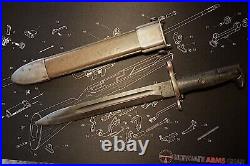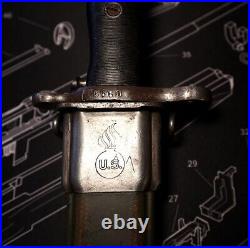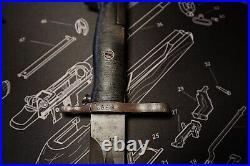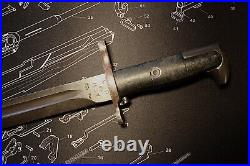






An original WWII US M1 9 3/4 Garand bayonet manufactured by American Fork and Hoe A. With US and Ordnance military flaming cannonball. With a black molded plastic handle. The scabbard is the correct M7 (briefly termed the M3A1). Scabbard also has the US and Ordnance military flaming cannonball marking. Both Bayonet and Scabbard show signs of wear from use in action. Marked and date: A. This is an original 9 3/4 blade made during 1943 and 1944. Army decided to shorten the M1905 bayonet’s blade to 9 3/4 inches (25.4 cm). Production of this new bayonet, designated the M1, began at five manufacturers by April 1943. In 1943 most of the M1905 bayonets already in service were recalled, their blades were cut down, and they were reissued; roughly 1 million bayonets underwent this process. The first shortened bayonets were delivered in September 1943, and deliveries continued at a rate of 40-50,000 per month until August 1945. All ten-inch bladed bayonets, whether new production M1 or cut-down M1905, were officially referred to as M1 bayonets, and the Army made no distinction between the two when issuing them.

